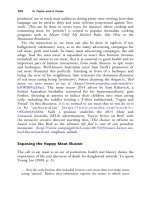The palgrave international handbook of a 346
Bạn đang xem bản rút gọn của tài liệu. Xem và tải ngay bản đầy đủ của tài liệu tại đây (39.31 KB, 1 trang )
344
C. Lawson
bloodlines and past performance, may often be beaten, drowned, shot or
strangled to death, sometimes on the night as entertainment for the other
participants.
Prevalence
In the USA, dog fighting has been estimated to be an industry worth in
excess of half a billion dollars, and involves approximately 40,000 dogmen
who can be categorised as professionals (Gibson 2005); up to $500,000
seized at one fight (Lockwood 2012, p. 8); and perhaps 2000 fights being
held per year7 (Strouse 2009, p. 17). Due to no standardised law enforcement data collection across the 50 states, the number of offences (both state
and federal), and the range of agencies involved, the tracking of dog fighting
cases has been problematic. Many have relied upon pet-abuse.com which
catalogues press reports of fighting cases. This may change as the FBI recategorised animal cruelty and began tracking data from 2016.
In the UK, dog fighting is predominantly investigated and prosecuted in
England and Wales by the animal welfare charity the RSPCA. The police will
sometimes investigate alone but they are far more likely to assist with RSPCA
investigations, whose own officers possess no power of entry or arrest. With
only two agencies involved, reporting could be expected to be clearer than
the USA. The nature of the way in which the UK Government collates its
own Crown Prosecution Service and court data suggests that RSPCA prosecutions are not always recorded by the Ministry of Justice. For example,
Table 1 details the official prosecution and conviction rates for dog fighting,
declared by the Government in 2015.8,9
This data does not reveal how many separate instances or cases of dog
fighting to which these prosecutions relate. It is perhaps symptomatic of one
of the problems of recording and tracking criminality in this sphere, that the
official data, in Table 1 above, and also the RSPCA’s data, in Table 2 below,
does not tally with those reported by Harding and Nurse (2015, pp. 49–50).
7
Strouse (2009) cites figures reported by the now-defunct Sporting Dog Journal to which dog fighters
submitted fight reports and applied for certificates of championship. Note the SDJ had, despite strict
conditions, 6,000 subscribers in its heyday. The publishers were arrested in 2004 and the SDJ ceased to
exist apart from one further edition in 2007.
8
Response in answer to Parliamentary Questions 223989 and 9486 answered on the 23rd March and 16 th
September 2015 respectively.
9
/>tion/Commons/2015-09-08/9486.









